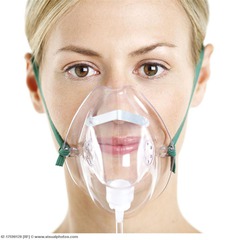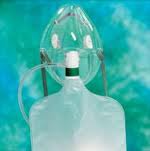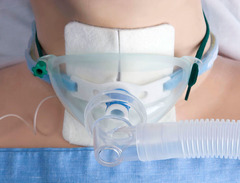Adult ATI: Airway Management Ch. 53 – Flashcards
Unlock all answers in this set
Unlock answersquestion
what does managing compromise include
answer
-respiratory assessment -measuring vital signs: O2 sats via pulse oximetry -administration of oxygen
question
what does administering oxygen do for pts
answer
helps maintain adequate cellular oxygenation for clients who have many acute and chronic respiratory problems or are at risk for hypoxia
question
what kind of pt's need to be administered oxygen
answer
-pt's who have acute/chronic respiratory problems (hypoxemia, cystic fibrosis, asthma) =pt's who are at risk for developing hypoxia (resp. illness, circulatory impairment)
question
what is a nursing priority with airway management
answer
maintaining a patent airway
question
what is involved with maintaining a patent airway
answer
-mobilizing secretions -suctioning airways -managing artificial airways (endotracheal tubes, tracheostomy tubes) promotes adequate gas exchange and lung expansion
question
pulse oximeter
answer
a device with a sensor probe that attaches securely to the fingertip, toe, bridge of nose, earlobe, or forehead with a clip or band
question
what does a pulse oximeter do
answer
measure pulse saturation (SPo2) via a wabe of infrared light that measures light absorption by oxygenated and deoxygenated hemoglobin in arterial blood
question
what does SPO2 reflect
answer
the percent of saturation of hemoglobin (SaO2) when the SaO2 is greater than 70 percent
question
how much of the atmospheric air is oxygen
answer
21 percent
question
oxygen rates vary to maintain...
answer
an SpO2 of 95-100 using the lowest amount of oxygen to achieve the goal without risking complications
question
FiO2 Fraction of inspired air
answer
the percentage of oxygen the client recieves
question
what findings during your assessment would cause you to need the pulse oximetry
answer
-increased work of breathing -wheezing -coughing -cyanosis -changes in respiratory rate or rhythm -adventitious breath sounds -restlessness, irritability, confusion
question
what are some interventions that can be done if you have a pulse oximetry reading of less than 90% (indicating hypoxemia)
answer
--confirm probe placement -confirm that o2 delivery system is functioning and that client is receiving the prescribed o2 levels -place the client in semi-fowler's or fowler's position to promote chest expansion and to maximize ventilation -encourage deep breathing -remain with the client and provide emotional support to decrease anxiety
question
what is an acceptable range of the pulse ox.
answer
91-100 percent some illnesses states can allow from 85-89 percent readings of less than 90 reflect hypoxemia
question
what reasons may cause a low pulse ox reading
answer
older adults clients who have darker skin hypothermia poor peripheral blood flow too much light low hemoglobin levels jaundice movement edema nail polish
question
what is oxygen therapy used for
answer
treating hypoxemia (low levels of arterial oxygen)
question
early manifestations of hypoxemia
answer
-tachypenia tachycardia restlessness anxiety confusion pale skin and mucous membranes elevated blood pressure use of accessory muscles, nasal flaring, tracheal tugging, adventitious lung sounds
question
what are late manifestations of hypoxemia
answer
stupor cyanotic skin, mucous membranes bradypnea bradycardia hypotension cardiac dysrhythmias
question
what are nursing actions that need to be considered with giving oxygen therapy
answer
-monitor respiratory rate and pattern -minitor level of conciousness -monitor SpO2 and ABG -provide ox. therapy at lower liter flow that will correct hypoxemia - make sure mask is placed on face correctly - assess/monitor for hypoxemia/hypercarbia (restlessness, hypertension, headache) -listen to lungs for breath sounds -assess/monitor pulse ox -promote oral hygiene -encourage turning, coughing, deep breathing and use of incentive spirometry and suctioning -assess and document the response to ox therapy -monitor for res. depression (decreased resp. rate and level of conciousness)
question
what rate of flow is a nasal canula
answer
low flow
question
nasal canula
answer
tubing with two small prongs fro insertion into the nares
question
what is the fraction of inspired oxygen for the nasal cannula
answer
FIO2: 24%-44% flow rate: 1-6 L/min
question
what are the advantages of a nasal cannula
answer
safe simple easy to apply comfortable well tolerated client able to eat, talk, ambulate
question
what are the disadvantages of a nasal cannula
answer
FiO2 varies with the flow rate, and rate and depth of clients breathing extended use can lead to skin breakdown and dry mucous membranes tubing is easily dislodged
question
what are some nursing actions to consider with the nasal cannula
answer
-assess patency of nares -ensure that the prongs fit in nares properly -use water soluble gel to prevent dry nares - provide humidification for flow rates of 4L/min and greater
question
what rate of flow should you provide humidification
answer
4 L/min or greater
question
Simple Face Mask

answer
covers clients nose and mouth
question
what is the fraction of inspired ox with the simple face mask
answer
FiO2: 40-60 percent Flow rate: 5 L/min to ensure flushing of CO2 from mask
question
what rate of flow is a simple face mask
answer
low flow
question
what are the advantages of a simple face mask
answer
-easy to pply -more comfy -simple delivery method -provides humified ox
question
disadvantages of a simple face mask
answer
-flow rate less that 5L/min can result in rebreathing of CO2 -clients who have anxiety or claustrophobia do not tolerate it well -eating, drinking and talking are impaired -moisture and pressure can collect under mask and cause skin breakdowns
question
nursing actions for a simple face mask
answer
-assess for proper fit to ensure a secure seal over the nose and mouth -make sure client wears a nasal cannula during meals -use with caution for clients who have a high risk of aspiration or airway obstruction -look for skin breakdown
question
what rate of flow is a partial rebreather mask
answer
low flow
question
partial rebreather mask

answer
covers pt's nose and mouth
question
what is the fraction of inspired ox for a partial rebreather mask
answer
FiO2: 40-70 percent Flow rate: 6-10 L/min
question
what are the advantages of a partial rebreather mask
answer
the mask has a reservoir bag attached with no valve which allows the client to rebreath up to 1/3 of exhaled air together with room air
question
disadvantages of partial rebreather
answer
-complete deflation of reservoir bag during inspiration causes CO2 buildup - the FiO2 varies with clients breathing pattern - clients who have anxiety or claustrophobia do not tolerate it well - eating, drinking and talking impaired
question
nursing actions with a partial rebreather mask
answer
-keep bag from deflating by adjusting oxygen flow rate to keep bad 1/3 to 1/2 full on inspiration -asses fit to ensure a secure seal over nose and mouth -look at skin for breakdown -use with caution for pt's who have risk of aspiration/obstruction
question
rate of flow for a nonbreather mask
answer
low flow
question
what is the FiO2 and flow rate for a nonrebreather mask
answer
FiO2: 60-100 percent Rate: 10-15 L/min to keep bag 2/3 full during inspiration and expiration
question
advantages of a nonrebreather mask
answer
-delivers highest O2 concentration possible (Except for intubation) - a one way valve situated between mask and reservoir allows client to inhale max o2 from reservoir bag. the two exhalation ports have flaps covering that that prevent room from entering the mask
question
disadvantages of non rebreather mask
answer
-valve and flap on mask by be intact and functional during each breath -poorly tolerated by clients who anxiety/claustrophobia -eating, drinking, talking impaired -caution with pt with high risk of aspiration and obstruction of airway
question
nursing actions of non rebreather mask
answer
-hourly assessment of valve and flap -asses pfit -assess for skin breakdown -use nasal canula durring meals
question
low flow oxygen delivery systems
answer
-nasal cannula -simple face mask -partial rebreather -nonrebreather mask
question
high flow oxygen delivery systems
answer
venturi mask aerosol mask
question
what is the fraction of inspired oxygen and rate of flow for the venturi mask
answer
FiO2: 24-100 percent Rate: 4-12 l/min via diff. size adapters, which allow specific amounts of air to mix with oxygen
question
advantages of venturi mask
answer
-delivers the most precise oxygen concentration -humidification not required -best for clients who have chronic lung disease
question
disadvantages of venturi mask
answer
-use is expensive -eating, drinking, talking impaired
question
nursing actions when using venturi mask
answer
-assess frequently to ensure an accurate flow rate -assess proper fit - assess for skin breakdown -make sure tubing is free of kinks -make sure pt's use nasal cannula sdu
question
flow rate of a aerosol mask
answer
high flow
question
aerosol mask
answer
aka a face tent
question
tracheostomy collar

answer
small mask that covers the surgically created opening of the trachea
question
what is the fraction of inspired ox for the aerosol mask
answer
FiO2: 24-100% rate: at least 10 L/mn provides high humidification with ox delivery
question
advantages of aerosol mask
answer
-used with pt who do not tolerate masks well -useful for clients who have facial trauma, burns and thick secretions
question
disadvantages of aerosol masks
answer
-high humidification requires frequent monitoring
question
nursing actions with aerosol makss
answer
-empty condensation from tubing often -ensure adequate water in the humidification canister -ensure aerosol must leaves from vents during inspiration and expiration -make sure tubing does not pull on tracheostomy
question
complications of oxygen therapy
answer
-oxygen toxicity -oxygen induced hypoventilation -combustion
question
what can oxygen toxicity result from
answer
high concentrations of oxygen (greater than 50 percent) long durations of oxygen therapy (more than 24-48 hours) severity of lung disease
question
manifestations of oxygen toxicity
answer
nonproductive cough substernal pain nasal stuffiness nausea vomiting fatigue headache sore throat hypoventilation
question
nursing actions with oxygen toxicity
answer
-use lowest level of oxygen necessary to maintain an adequate SPO2 -monitor ABG's and notify provider if SPO2 levels are outside expected reference range -decrease FiO2 as the clients SPO2 improves
question
what clients can oxygen induced hypoventilation happen in
answer
those that have conditions that cause alveolar hypoventilation can be sensitive to admin of oxygen
question
nursing actions with oxygen induced hypoventilation
answer
-monitor respiration rate, pattern, level of conciousness, and SpO2 -provide oxygen therapy at the lowest liter flow rate that manages hypoxemia, -if they can tolerate it use a venturi mask to deliver precise oxygen levels -notify provider if impending respiratory depression such as a decreased rep. rate and a decreased LOC
question
what are nursing actions that can be done to prevent combustion with use of oxygen
answer
-post no smoking or oxygen in use signes to alert others of a fire hazard -know where to find closest fire extinguisher - educate about the fire hazard of smoking with oxygen use -have clients ear a cotton gown because synthetic or wool fabrics can generate static electricity - ensure that all electric devices are working well -make sure all electric machinery are grounded -do not use volatile flammable materials near clients receiving oxygen
question
what are nursing interventions that mobilize secretions and maintain airway patency what do these interventions do for the pt
answer
-assistance with coughing -hydration -positioning -humidification -nebulizer therapy -chest physiotherapy -suctioning -they promote adequate gas exchange and lung expansion
question
what is at risk for developing airway compromise
answer
infants clients who have a neuromuscular disorders quadriplegic cystic fibrosis pt's
question
indications that clients need help maintaining airway clearance
answer
-hypoxemia -restlessness -irritability -tachypnea -tachycardia -cyanosis -decreased levels of conciousness -adventitious breath sounds -visible secretions -absence of spontaneous cough
question
what does humidification do for preventing obstruction of airways
answer
humidified oxygen moistens the airways which loosens and mobilizes pulmonary secretions
question
what does nebulization do for ensuring airway clearance
answer
breaks up medications (bronchodilators, mucolytic agents) into minute particles that disperse throughout the resp. tract and improves clearance of pulmonary secretion
question
what is chest physiotherapy
answer
the use of chest percussion, vibration , and postural drainage to help mobilize secretion
question
what does chest percussion and vibration do for airway clearance
answer
it facilitates movement of secretions into the central airways
question
what does postural drainage to for airway clearance
answer
one or more positions allow gravity to assist with the removal of secretions form specific areas of the lung
question
what does early morning postural drainage to for airway clearance
answer
it mobilizes secretions that have accumulated through the night
question
how should the nurse collect sputum specimens
answer
by suctioning during coughing
question
whenever possible what should a nurse instruct the pt to do to collect a specimen or help airway clearance why?
answer
-encourage coughing -coughing is more effective that artificial suctioning at moving secretions into upper trachea and laryngopharynx
question
what should the nurse do to avoid bacterial contamination when ensuring airway clearance and collecting a sputum specimen
answer
maintain surgical asepsis when performing any form of tracheal suctioning
question
what is sputum specimen collection used for
answer
-cytology to id aberrant cell or cancer -for culture and sensitivity to grow and id micro-organisms and the antibiotics effective against them -to id acid fast bacillus to diagnose TB (requires three consecutive morning samples)
question
when should you collect specimens for sputim
answer
in the morning
question
if the pt eats when should you collect a sputum specimen and why
answer
wait 1 to 2 hours after they eat to decrease the likelihood of emesis or aspiration
question
what kind of container should you use to collect a sputum specimen for cytology
answer
a container with a preservitive
question
what kind of container would you use for a routine and AFB sputum specimen collection
answer
a sterile container
question
how would you collect a sputum specimen if the client cannot cough effectively and expectorate sputum into the container
answer
collect the specimen by endotracheal suctioning
question
when would chesty physiotherapy be contraindicated
answer
-pregnant -have a rib, head, chest or neck injury -have increased intracranial pressure -recent abdominal surgery -have pulmonary embolism -have bleeding disorders -have osteoporosis
question
percussion
answer
the use of cupped hands to clap rhythmically on the chest to break up secretions
question
vibrations
answer
the use of shaking movements during exhalation to help remove secretions
question
postural drainage
answer
the use of various positions to allow secretions to drain by gravity
question
when should you schedule chesty physiotherapy if the pt has eaten
answer
1 to 2 hours after eating and at bedtime to decrease the likelihood of vomiting or aspirating
question
what should you do 30 min to 1 hour before postural drainage
answer
administer a bronchodilator meds or a nebeulizer
question
how do you create vibrations to mobilize secretions in the chest
answer
-place hands on the affected area -tense hand and arm muscles -move the heal of the hands to create vibrations as the client exhales -have the client cough after each set of vibrations
question
how long should each pt remain in each position during chest physiotherapy
answer
10 to 15 min to allow time for percussion, vibration, and postural drainage
question
when should you discontinue chest physiotherapy
answer
faintness or dizziness
question
what should you encourage pt's to do when you are suctioning
answer
breath deeply and cough in an attempt to clear the secretions with artificial suctioning
question
what should you use for oropharyngeal suctioning
answer
a yankauer or tonsil tipped rigid suction catheter and move it around the mouth gum line and pharynx
question
what do you use for nasopharyngeal suctioning and nasotracheal suctioning
answer
use a flexible catheter and lubricate the distal 6 to 8 cm with water soluble lubricant
question
what do you use for endotracheal suctioning
answer
suction catheter should not exceed one half of the internal diameter of the endotracheal tube to prevent hypoxia
question
the nurse should use what size ffrench suction cathetar when suctioning a 8mm endotracheal and tracheostomy tube
answer
16 frech
question
how long should you limit each suction attempt
answer
10-15 secs to avoid hypoxia and the vagal response
question
use suction pressure no higher than
answer
120-150 mmHg
question
limit total suction time to
answer
5 min
question
when should you insert the cathetar for nasopharyngeal or nastracheal suctioning
answer
during inhalation do not apply while inserting
question
how far do you advanse the nasal suctioning cathetar
answer
the top of the nose to the base of the earloabe
question
when do you apply suctioning nasaly
answer
only while withdrawing the catheter and rotating it with the thumb and forefinger
question
how many passes do you do with nasopharangyl or nasotracheal suctioning
answer
no more than wo passes allow at least one min between passes for ventilation and oxygenation
question
how far do you insert a endotracheal suctioning cathetar
answer
until resistance is met then pull back 1 cm prior to apply suction to prevent mucosal damage
question
how should you suction with endotracheal suctioning
answer
intermittently by covering and releasing suction port with the thumb for 10 to 15 secs
question
when do you apply suction when endotracheal suctiong
answer
only while withdrawing the catheter and rotating it with forefinger and thumb



